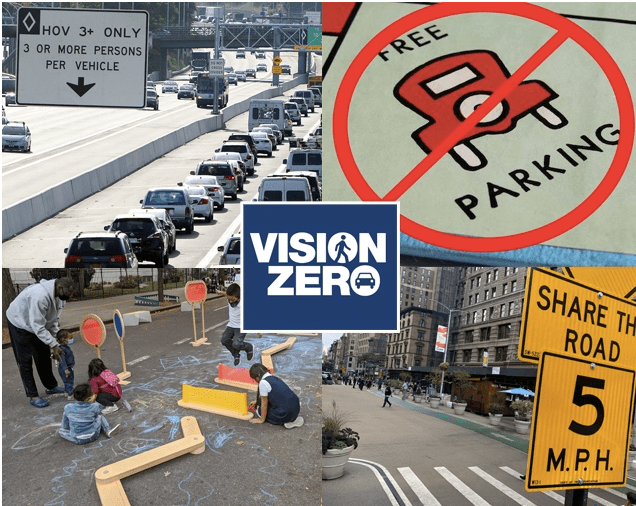The City Council’s “oversight” hearing on Mayor de Blasio’s Vision Zero initiative was a six-hour slog triumph of public involvement in the creation and implementation of policy, with dozens of people and lawmakers giving examples of the many ways in which the mayor’s signature initiative has failed — and this year’s death count provided an essential backdrop.
Obviously many people cited Streetsblog’s recent investigation into the NYPD’s failure to respond to many 311 complaints — what one man called “NYPD’s 311 fraud” — while others testified in support of crucial council bills, such as Steve Levin’s proposal to allow the public to report illegally parked cars (and pocket some of the ticket profits), Bob Holder’s bill to ban license plate covers, Inez Barron’s long-delayed bill to require stop signs at schools, and Ben Kallos’s bill to decriminalize jaywalking (and therefore eliminate the NYPD’s racially biased ticketing for this universal “crime”).
And there was plenty of tearful testimony — including from the daughter of Ada Martinez, a cyclist killed in 2019 because of an illegally parked truck, and the wife of Jeffrey Williamson, who was killed earlier this year by a postal service driver — in support of such bills and other measures.
But what were the best ideas for actually fixing Vision Zero? Here’s a summary:
1. Reduce parking
Following calls from just about everyone (including himself!), Jehiah Czebotar called for the Council to “require DOT to reduce on-street parking by 10 percent every year until the number of vehicles crossing bridges in New York City drops 50 percent [and] require DOT to expand the number of metered parking spaces by 10 percent each year until the city is no longer subsidizing car storage and the number of registered vehicles in NY drops by 50 percent.” Others spoke of eliminating mandatory parking minimums that require developers to add parking to their projects.
Sara Lind, the director of policy at Open Plans, the livable streets nonprofit, pointed out some of the great public benefits to reducing parking: “Trash containerization; commercial loading zones; daylighting, neckdowns, and other safety improvements; bike corrals and bike share; public seating.”
Bottom line? “Free parking is an impediment to street safety,” added Choresh Wald.
Gutman focuses largely on topics outside of his agency's remit like drivers with suspended licenses (DMV), an increase in for-hire vehicles (TLC), and expanding speed camera programs (state legislature)
— Kevin Duggan (@kduggan16) October 26, 2021
9. Truly end placard abuse
The de Blasio administration has long talked about placard abuse, but expanded the distribution of them and then failed to crack down on misuse of them.
Czebotar went for a true zero tolerance policy, arguing that a city employee who “parks on a sidewalk” should lose his or her job. He also argued that DOT should be “the only city agency to issue parking placards or permitting for on-street parking” (currently, so many agencies issue legit placards that fake placards are hard to discern).
The keepers of the Placard Abuse Twitter account also testified in writing about the myriad problems with fake placards created by agencies or people who should not be legally authorized to create them: “Why are the unions that represent members of the NYPD, FDNY, Probation and other departments allowed to produce their own fake placards that are designed to appear like they were issued by city agencies?”
The large Riders Alliance/TA coalition added that “the special parking privileges afforded to city workers and other VIPs” — which the group estimated as “upwards of 125,000 placards” — creates “immeasurable waste, fraud, and abuse of authority.”
And the result is choked streets, thanks to cars being left in places where DOT did not design for car storage. As Council Member Steve Levin put it, “You can’t throw a tennis ball in Downtown Brooklyn without hitting an illegally parked car with a placard.”
Michelle Kuppersmith also targeted cops: “The NYPD cannot be on the front lines of enforcement — they’re the ones who are breaking the law.”
10. Don’t forget kids
Street safety activist Doug Gordon yielded his time to his 8-year-old son, Zeb, who spoke eloquently about how dangerous his neighborhood streets are.
“Dangerous drivers sometimes just look at their phones and that is dangerous because drivers just zoom across a red light and some people might be walking,” said the Park Slope savant.
“So if there were fewer cars it would be safer! If cars were limited I could bike to school more often and there wouldn’t be so much climate change.”
And here’s one we didn’t hear
Every member of the Council should give up his car, City Hall parking space and placard to lead by example and show that our elected officials are willing to be occasionally inconvenienced in order to save lives, speed bus riders and reduce pollution that is causing climate change.
Did we miss anything? Please put your testimony in the comments below.






